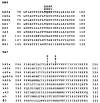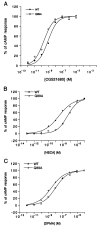Hydrophilic side chains in the third and seventh transmembrane helical domains of human A2A adenosine receptors are required for ligand recognition
- PMID: 8794889
- PMCID: PMC3418326
Hydrophilic side chains in the third and seventh transmembrane helical domains of human A2A adenosine receptors are required for ligand recognition
Abstract
Hydrophilic residues of the G protein-coupled human A2A adenosine receptor that are potentially involved in the binding of the ribose moiety of adenosine were targeted for mutagenesis. Residues in a T88QSS91 sequence in the third transmembrane helical domain (TM3) were individually replaced with alanine and other amino acids. Two additional serine residues in TM7 that were previously shown to be involved in ligand binding were mutated to other uncharged, hydrophilic amino acids. The binding affinity of agonists at T88 mutant receptors was greatly diminished, although the receptors were well expressed and bound antagonists similar to the wild-type receptor. Thus, mutations that are specific for diminishing the affinity of ribose-containing ligands (i.e., adenosine agonists) have been identified in both TM3 and TM7. The T88A and T88S mutant receptor fully stimulated adenylyl cyclase, with the dose-response curves to CGS 21680 highly shifted to the right. A Q89A mutant gained affinity for all agonist and antagonist ligands examined in binding and functional assays. Q89 likely plays an indirect role in ligand binding. S90A, S91A, and S277C mutant receptors displayed only moderate changes in ligand affinity. A S281N mutant gained affinity for all adenosine derivatives (agonists), but antagonist affinity was generally diminished, with the exception of a novel tetrahydrobenzothiophenone derivative.
Figures






Similar articles
-
Glutamate residues in the second extracellular loop of the human A2a adenosine receptor are required for ligand recognition.Mol Pharmacol. 1996 Apr;49(4):683-91. Mol Pharmacol. 1996. PMID: 8609897 Free PMC article.
-
Site-directed mutagenesis identifies residues involved in ligand recognition in the human A2a adenosine receptor.J Biol Chem. 1995 Jun 9;270(23):13987-97. doi: 10.1074/jbc.270.23.13987. J Biol Chem. 1995. PMID: 7775460 Free PMC article.
-
Identification of domains of the human A1 adenosine receptor that are important for binding receptor subtype-selective ligands using chimeric A1/A2a adenosine receptors.J Biol Chem. 1995 Sep 1;270(35):20485-90. doi: 10.1074/jbc.270.35.20485. J Biol Chem. 1995. PMID: 7657625
-
Adenosine receptors: protein and gene structure.Arch Int Pharmacodyn Ther. 1995 Jan-Feb;329(1):135-50. Arch Int Pharmacodyn Ther. 1995. PMID: 7639615 Review.
-
The role of receptor structure in determining adenosine receptor activity.Pharmacol Ther. 2000 Feb;85(2):55-75. doi: 10.1016/s0163-7258(99)00051-0. Pharmacol Ther. 2000. PMID: 10722120 Review.
Cited by
-
Chemogenomic analysis of G-protein coupled receptors and their ligands deciphers locks and keys governing diverse aspects of signalling.PLoS One. 2011 Feb 4;6(2):e16811. doi: 10.1371/journal.pone.0016811. PLoS One. 2011. PMID: 21326864 Free PMC article.
-
Sodium ion binding pocket mutations and adenosine A2A receptor function.Mol Pharmacol. 2015 Feb;87(2):305-13. doi: 10.1124/mol.114.095737. Epub 2014 Dec 3. Mol Pharmacol. 2015. PMID: 25473121 Free PMC article.
-
Neoceptor concept based on molecular complementarity in GPCRs: a mutant adenosine A(3) receptor with selectively enhanced affinity for amine-modified nucleosides.J Med Chem. 2001 Nov 22;44(24):4125-36. doi: 10.1021/jm010232o. J Med Chem. 2001. PMID: 11708915 Free PMC article.
-
Structural determinants of A(3) adenosine receptor activation: nucleoside ligands at the agonist/antagonist boundary.J Med Chem. 2002 Sep 26;45(20):4471-84. doi: 10.1021/jm020211+. J Med Chem. 2002. PMID: 12238926 Free PMC article.
-
Co-evolving stability and conformational homogeneity of the human adenosine A2a receptor.Proc Natl Acad Sci U S A. 2008 Aug 5;105(31):10744-9. doi: 10.1073/pnas.0804396105. Epub 2008 Jul 29. Proc Natl Acad Sci U S A. 2008. PMID: 18664584 Free PMC article.
References
-
- Libert F, Parmentier M, Lefort A, Dinsart C, van Sande J, Maenhaut C, Simons MJ, Dumont JE, Vassart G. Selective amplification and cloning of four new members of the G protein-coupled receptor family. Science (Washington D. C.) 1989;244:569–572. - PubMed
-
- Jacobson M. Molecular biology of adenosine receptors. In: Belardinelli L, Pelleg A, editors. Ad.snosine and Adenine Nucleotides: From Molecular Biology to Integrative Physiology. Kluver; Norwell, MA: 1995. pp. 5–14.
-
- Barraco RA, Martens K, Parizon M, Normile HJ. Role of adenosine A2a receptors in the nucleus-accumbens. Prog. Neuropsychopharmacol. Biol. Psychiatry. 1994;18:545–553. - PubMed
-
- Olsson RA, Pearson JD. Cardiovascular purinoceptors. Pharmacol. Rev. 1990;3:761–845. - PubMed
MeSH terms
Substances
Grants and funding
LinkOut - more resources
Full Text Sources
Other Literature Sources
Molecular Biology Databases
